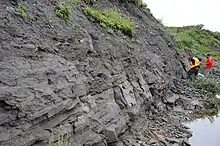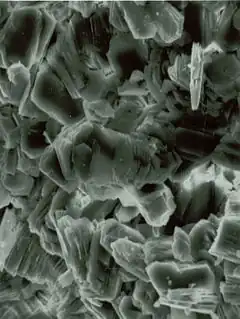Nanushuk Group
The Nanushuk Group or Nanushuk formation is a geologic group in Alaska in westernmost National Petroleum Reserve in Alaska (NPR-A). Oil in these rocks likely was generated beneath Western North Slope and migrated northeastward into NPR-A. It preserves fossils dating back to the Cretaceous period.[1] Underneath the Nanushuk lies the Torok Formation.[2]: 2

| Nanushuk Group | |
|---|---|
| Stratigraphic range: Cretaceous | |
 Kaolinite in sandstone from the Nanushuk Group | |
| Type | Group |
| Location | |
| Region | Alaska |
| Country | United States |
Geology
The Nanushuk Formation together with the Torok Formation below it forms a huge wedge of sediment deposited in a deep water basin and stretches from north of the Brooks Range beneath the Alaska North Slope to the adjacent offshore. It was deposited in shallow water and includes potential reservoirs in deltaic, shoreface, and fluvial sandstones. The USGS found large-scale folds and faults in the South of the formation and evidence, that the rocks have been heated to temperatures at which oil is converted to natural gas.[2]
History
Before 2015, over a period of more than 50 years about 150 oil exploration wells had been drilled into the Nanushuk and Torok Formations, yet oil production had had almost zero success finding one small oil pool with less than 50 million barrels in place. Nanushuk as a legitimate play was ignored.
In 2015 this status changed as the European Energy Company Repsol, discoverer ⁸of the super giant Vaca Muerta play, accompanied by the non operating partner Armstrong and led by the godfather of the Vaca Muerta success, announced it had discovered the Pikka oil pool in the Nanushuk Formation.
This discovery was based upon a critical revaluation of a well drilled to deeper objectives in 2013. This well had been briefly tested with a thin section of clean sands being opened to flow. The test was curtailed due to the imminent closure of the North Slope at the end of the winter drilling season. Only water was produced to surface during the flow period but oil was recovered during well kill operations.
Analysis of the limited test data revealed that the at least 5 MilliDarcy Formation had not been open sufficient time to get oil to surface after recovering drilling fluids lost to the formation.
Examination of core photographs from the Nanushuk revealed that, apart from some limited thickness clean sand bodies, typical in this sedimentary environment, the main section consisted of a thick sequence of siltstones interbedded by clean sand s with individual lithologies not normally exceeding 6 inches (15 cm).
More remarkable was the pervasive presence of bioturbation with worm burrows crossing between the silts and sands. Under normal circumstances vertical flow would be much reduced in stacked silt and shale sequences but the bioturbation was sufficient to guarantee efficient vertical recovery.
Another effect of the stacking was to suppress the electric log responses and it was determined that the original log analysis work had failed to recognize the true nature of the formation. More detailed and less pedestrian petrophysical analysis showed potential throughout the Nanushuk and extending into the underlying Torok.
Given the short drilling window it was decided that a new vertical well would be drilled, cored, logged and tested at the same time as a horizontal well was constructed, fractured and tested as a twin to the original well. Both wells proved the existence of the biggest conventional discovery for decades in the USA.
In 2017, ConocoPhillips announced discovery of the Willow oil pool in the Nanushuk Formation with estimated resources of more than 300 MMBO.[2] As of 2017, the U.S. Geological Survey estimated that there were 8.7 billion barrels of oil and 25 trillion cubic feet of natural gas in the Nanushuk and Torok Formations, much more than previously estimated.[2]
References
- "Fossilworks: Gateway to the Paleobiology Database". www.fossilworks.org. Retrieved 2023-03-14.
- David W. Houseknecht, Richard O. Lease, Christopher J. Schenk, Tracey J. Mercier, William A. Rouse, Palma J. Botterell, Katherine J. Whidden, Christopher P. Garrity, Kristen A. Lewis, Samuel J. Heller, William H. Craddock, Timothy R. Klett, Phuong A. Le, Rebecca A. Smith, Marilyn E. Tennyson, Stephanie B. Gaswirth, Cheryl A. Woodall, Michael E. Brownfield, Heidi M. Leathers-Miller, Thomas M. Finn (2017). "Assessment of undiscovered oil and gas resources in the Cretaceous Nanushuk and Torok Formations, Alaska North Slope, and summary of resource potential of the National Petroleum Reserve in Alaska, 2017". U.S. Geological Survey. doi:10.3133/fs20173088.
{{cite journal}}: CS1 maint: multiple names: authors list (link)
Further reading
- Various Contributors to the Paleobiology Database. "Fossilworks: Gateway to the Paleobiology Database". Retrieved 17 December 2021.